MAINTENANCE AND REPAIR
ON-VEHICLE SERVICE
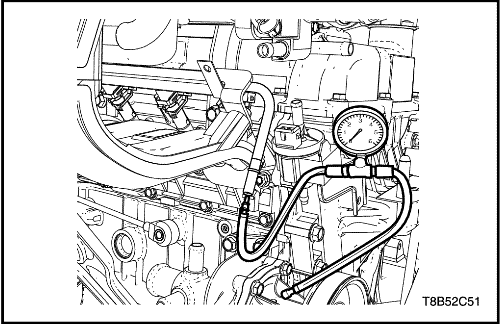


Fuel Pressure Test
Tools Required
DW100-010 Gauge-Fuel Pressure Measuring
Caution : The fuel system is under pressure. To avoid fuel spillage and the risk of personal injury or fire, it is necessary to relieve the fuel system pressure before disconnecting the fuel lines.
- Relieve the fuel pressure.
- Remove the air cleaner assembly. Refer to Section 1C1, Engine Mechanical.
- Install the Gauge-Fuel Pressure Measuring(DW100-010).
- Measure the fuel pressure.
- Fuel Pressure Spec.: 380Kpa (Battery Voltage:13.2V)



Fuel Tank
Removal Procedure
Caution : The fuel system is under pressure. To avoid fuel spillage and the risk of personal injury or fire, it is necessary to relieve the fuel system pressure before disconnecting the fuel lines.
- Relieve the fuel pressure. Refer to "Fuel Pump & Fuel Sender" in this section.
- Disconnect the negative battery cable.
- Drain the fuel tank.
- Disconnect the parking brake cable retainer clamps
and the support along the fuel tank to provide clearance
for the tank.
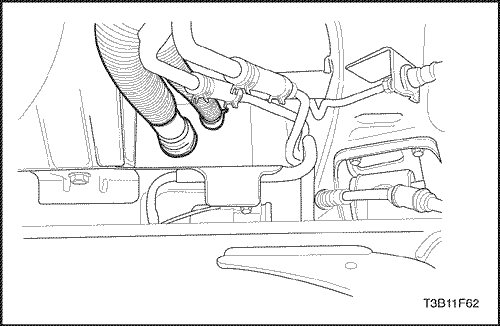


- Remove the fuel tank filler tube clamp at the fuel tank.
- Disconnect the fuel tank filler tube.
- Disconnect the fuel tank filler tube at the fuel tank.
- Disconnect the canister vapor tube at control valve
vapor tube.
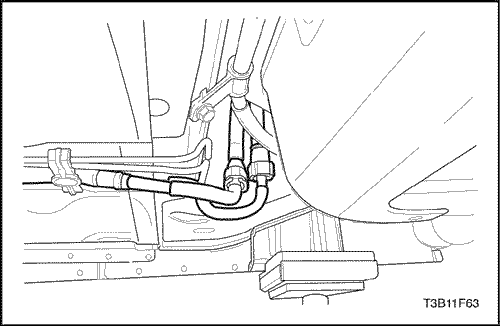


- Disconnect the fuel pump harness connector at the
right rear corner of the fuel tank.
- Disconnect the fuel inlet line near the right front of the fuel tank.
- Disconnect the wiring harness clips and the fuel line
clips as needed.
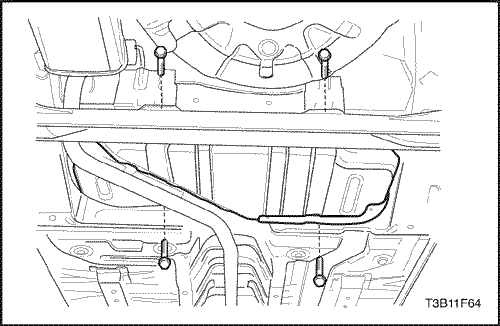


- Support the fuel tank.
- Remove the fuel tank retaining bolts.
- Carefully lower the fuel tank.
- Remove the fuel tank.
- Transfer any parts as needed.



Installation Procedure
- Raise the fuel tank into position.
- Install the fuel tank mounting bolts.
Tighten
Tighten the fuel tank retaining bolts to 20 N•m
(15 lb-ft).
- Connect the fuel outlet line.
- Connect the wiring harness clips and the fuel line
clips as needed.
- Connect the fuel pump electrical connector.
- Connect the fuel vapor line.
- Connect the fuel tank filler tube and fuel tank vent tube.
- Install the fuel tank filler tube clamp at the fuel tank.



- Install the parking brake cable retainer clamps and
the support.
Tighten
Tighten the parking brake cable retainer clamps to
10 N•m (89 lb-in ).
- Connect the negative battery cable.
- Fill the fuel tank.
- Perform a leak check of the fuel tank and the fuel
line connections.
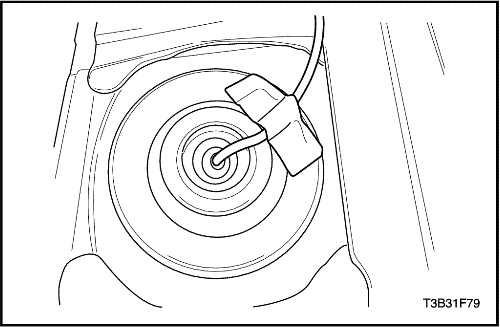


Fuel Pump & Fuel Sender
Tools Required
EN-49090 Remover/Installer-Fuel Pump Lock Ring
Removal Procedure
Caution : The fuel system is under pressure. To avoid fuel spillage and the risk of personal injury or fire, it is necessary to relieve the fuel system pressure before disconnecting the fuel lines.
- Relieve the fuel pressure.
- Disconnect the negative battery cable.
- Remove the rear seat. Refer to Section 9H, Seats.
- Remove the fuel pump access cover.



- Loosen the locking by pushing the fuel pump electrical connector tap.
- Disconnect the electrical connector at the fuel pump assembly.
- Disconnect the fuel outlet line.
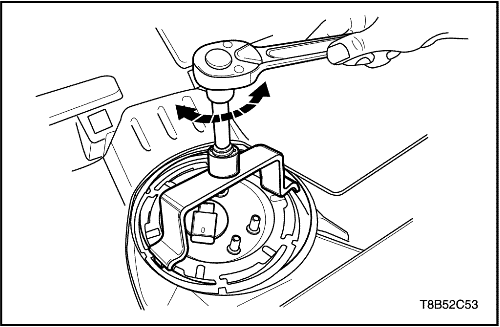


- Remove the fuel pump lock ring by using remover/installer-fuel pump lock ring(EN-49090).
- Remove the fuel pump.
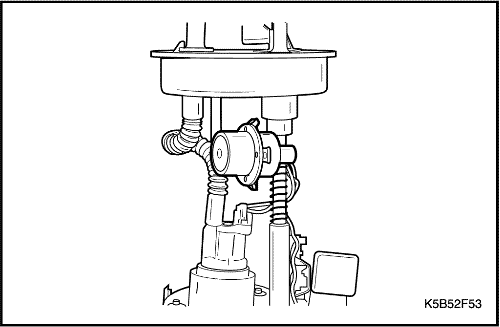


- Disconnect the insulator.



- Remove the fuel sender assembly.
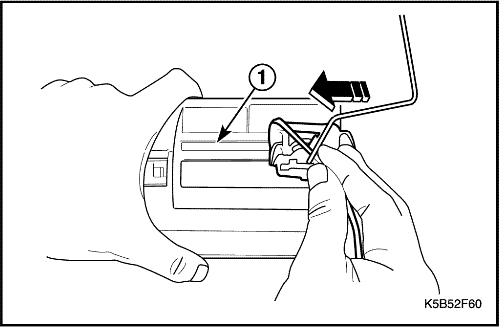


Installation Procedure
Caution : Be careful to install the fuel sender to fuel pump housing exactly. If not installed exactly, fuel indicating may be incorrect.
- Install the fuel sender assembly.



- Connect the fuel sender insulator.



- Install the fuel pump to fuel tank.
- Install the fuel pump lock ring by using remover/installer-fuel pump lock ring (EN-49090).



- Connect the electrical connector at the fuel pump assembly.
- Tighten the locking by pushing the fuel pump electrical connector tap.
- Connect the fuel outlet line.



- Install the fuel pump access cover.
- Connect the negative battery cable.
- Perform an operational check of the fuel pump.
- Install the rear seat Refer to Section 9H, Seats.
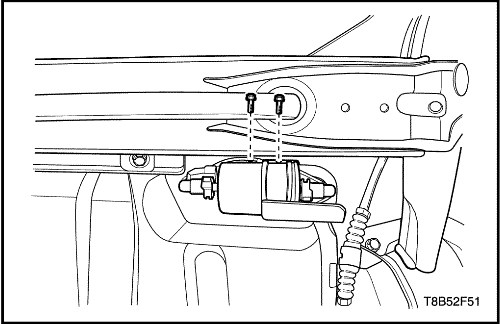


Fuel Filter
Removal Procedure
Caution : The fuel system is under pressure. To avoid fuel spillage and the risk of personal injury or fire, it is necessary to relieve the fuel system pressure before disconnecting the fuel lines.
- Relieve the fuel pressure.
- Disconnect the negative battery cable.
- Disconnect the inlet/outlet fuel lines by moving the line connector lock forward and pulling the hose off of the fuel filter tube.
- Remove the fuel filter bracket bolts.
- Remove the fuel filter.



Installation Procedure
- Install the fuel filter.
- Install the fuel filter bracket bolts.
- Connect the inlet/outlet quick connector lines.
- Connect the negative battery cable.
Fuel Rail and Injectors
Removal Procedure
Caution : The fuel system is under pressure. To avoid fuel spillage and the risk of personal injury or fire, it is necessary to relieve the fuel system pressure before disconnecting the fuel lines.
- Disconnect the negative battery cable.
- Relieve the fuel pressure.
- Remove the air cleaner assembly. Refer to Section 1C1, Engine Mechanical.
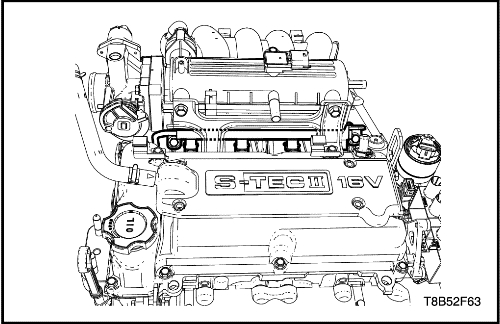


- Disconnect the quick connector fuel feed line from the fuel rail.
- Disconnect the wiring harness from the upper side of the fuel rail.
- Disconnect the fuel injector harness connector.
- Remove the fuel rail mounting bolts.
- Remove the fuel rail with the fuel injectors attached.
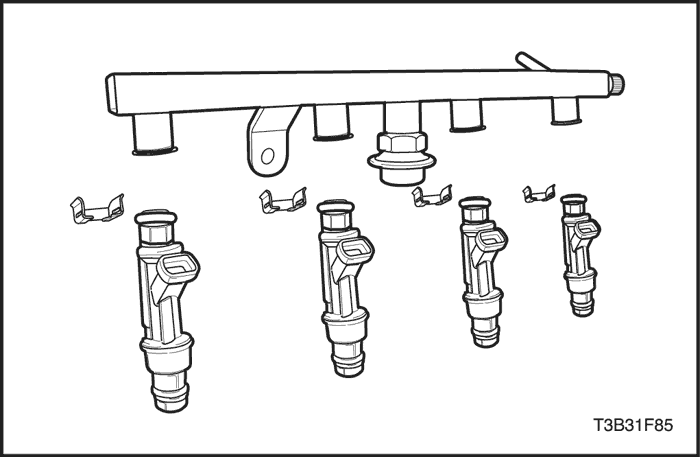


- Remove the fuel injector retainer clips.
- Remove the fuel injectors by pulling down and out.
- Discard the fuel injector O–rings.
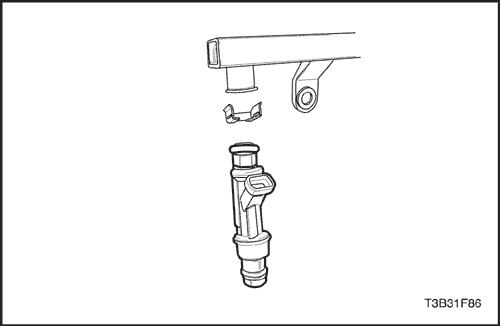


Installation Procedure
Important : Different injectors are calibrated for different flow rates. When ordering new fuel injectors, be certain to order the identical part number that is inscribed on the old injector.
- Install the new O–rings on the fuel injectors.
- Install the retainer clip after installing injectors on the fuel rail.



- Install the fuel rail and injector assembly to the intake manifold.
- Install the fuel rail retaining bolts.
Tighten
Fuel Rail Retaining Bolt to 10 N•m (7.3 lb-ft).
- Connect the fuel injector harness connectors.
- Connect the harness on the upper side of the fuel rail.
- Connect the quick connector fuel feed line on the fuel rail.
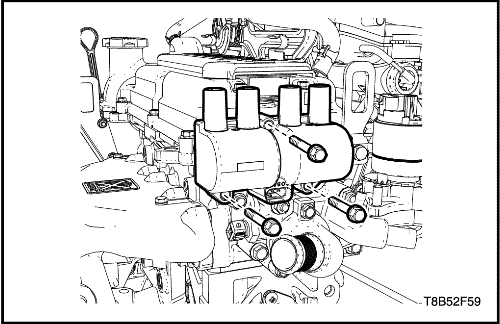


Ignition Coil (DIS) & Bracket
Removal Procedure
- Disconnect the negative battery cable.
- Remove the ignition cable.
- Disconnect the ignition cable harness connector.
- Remove the ignition coil retaining bolts.
- Remove the ignition coil.
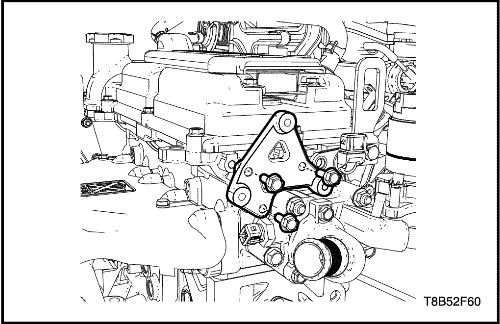


- Remove the ignition coil bracket retaining bolts.
- Remove the ignition coil bracket.



Installation Procedure
- Install the ignition coil bracket.
- Install the ignition coil bracket retaining bolts.
Tighten
Ignition Coil Bracket Retaining Bolt to 10 N•m (7.3 lb-ft).



- Install the ignition coil.
- Install the ignition coil retaining bolts.
Tighten
Ignition Coil Retaining Bolt to 10 N•m (7.3 lb-ft).
- Connect the ignition coil harness connector.
- Connect the ignition cable.
- Connect the negative battery cable.
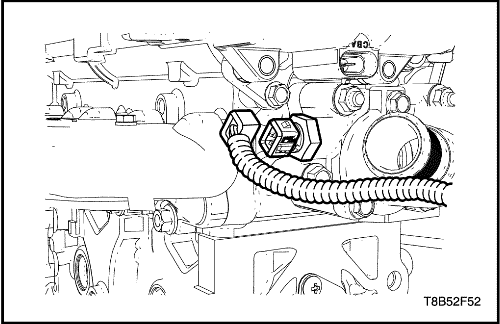


Engine Coolant Temperature (ECT) Sensor
Removal Procedure
Notice : Use care when handling the ECT sensor. Damage to the sensor will affect the proper operation of the fuel injection system.
- Relieve the coolant system pressure and remove the coolant. Refer to Section 1D, Engine Cooling.
- Disconnect the negative battery cable.
- Disconnect the engine coolant temperature (ECT) sensor connector.
- Carefully remove the ECT sensor.



Installation Procedure
- Install the ECT sensor.
Tighten
Engine Coolant Temperature Sensor Bolt to 17.5 N•m (12.9 lb-ft).
- Connect the engine coolant temperature (ECT) sensor connector.
- Connect the negative battery cable.
- Fill the cooling system. Refer to Section 1D, Engine Cooling.
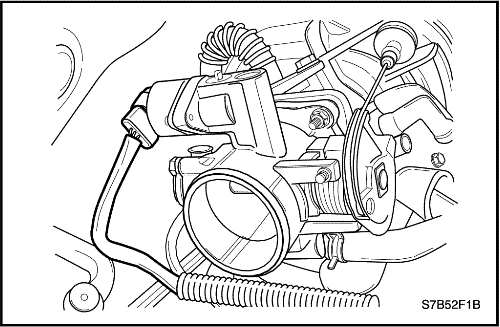


Throttle Position Sensor
Removal Procedure
- Disconnect the negative battery cable.
- Remove the air cleaner assembly. Refer to Section 1C1, Engine Mechanical.
- Disconnect the throttle position sensor (TPS) connector.
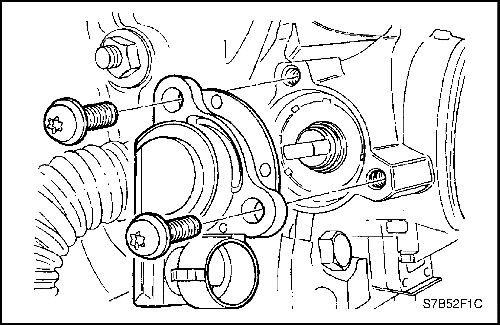


- Remove the TPS retaining bolts.
- Remove the TPS.



Installation Procedure
- Install the TPS.
- Install the TPS retaining bolts.
Tighten
Throttle Position Sensor(TPS) Retaining Bolts: 2.7 N•m (23.9 lb-in).



- Connect the throttle position sensor(TPS) connector.
- Install the air cleaner assembly. Refer to Section 1C1, Engine Mechanical.
- Connect the negative battery cable.
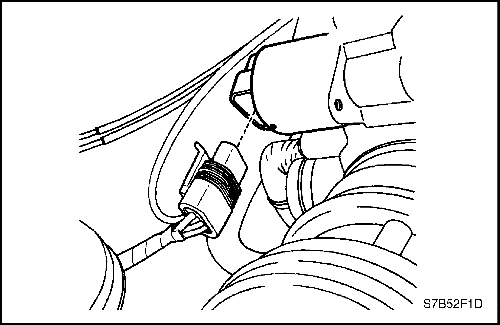


Idle Air Control Valve (IACV)
Removal Procedure
- Disconnect the negative battery cable.
- Disconnect the idle air control valve(IACV) connector.
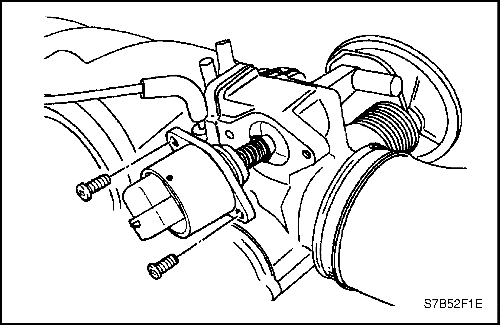


Notice : Clean the IAC valve O–ring seal area, the pintle valve seat and the air passage with a suitable fuel system cleaner. Do not use methyl ethyl ketone.
- Remove the IACV retaining bolts.
- Remove the IACV.



Installation Procedure
Notice : If installing a new IAC valve, be sure to replace it with an identical part. On IACV that have been in service, do not push on the valve pintle. The force required to move the pintle may damage the threads on the worm drive.
- Install the new O–ring seal with the IACV.
- Install the IACV retaining bolts.
Tighten
Idle Air Control Valve(IACV) Retaining Bolts to 3 N•m (27 lb-in).



- Connect the IACV connector.
- Connect the negative battery cable.
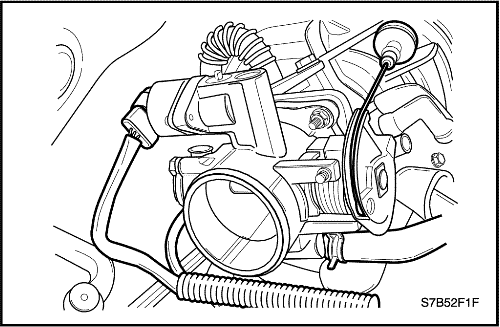


Throttle Body
Removal Procedure
Notice : Be careful to be poured when removing the throttle body. Close the coolant inlet & outlet hose using a adequate tool.
- Disconnect the negative battery cable.
- Remove the air cleaner assembly. Refer to Section 1C1, Engine Mechanical.
- Disconnect the throttle cable.
- Disconnect the throttle position sensor(TPS) connector.
- Disconnect the coolant inlet & outlet hose.
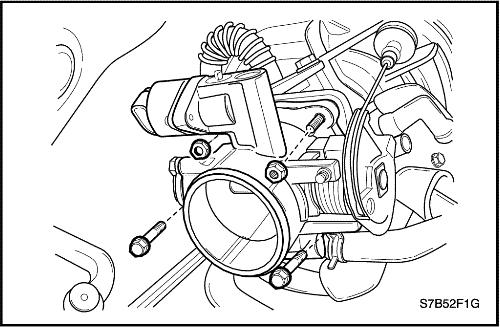


Notice : Close the entrance of the intake manifold after removing the throttle body and any dirt should not be entered.
- Remove the throttle body retaining bolts and nuts.
- Remove the throttle body with the gasket.



Installation Procedure
- Install the throttle body with the NEW throttle body gasket.
- Tighten the throttle body retaining bolts and nuts.
Tighten
Throttle Body Retaining Nuts to 10.5 N•m (7.7 lb-ft).



Notice : After connecting the throttle cable, check the throttle valve is closed fully. And check if there is a contact to the accelerator pedal when stoping the engine.
- Connect the throttle cable.
- Connect the throttle position sensor(TPS) & IACV connector.
- Connect the coolant hose.
- Connect the negative battery cable.
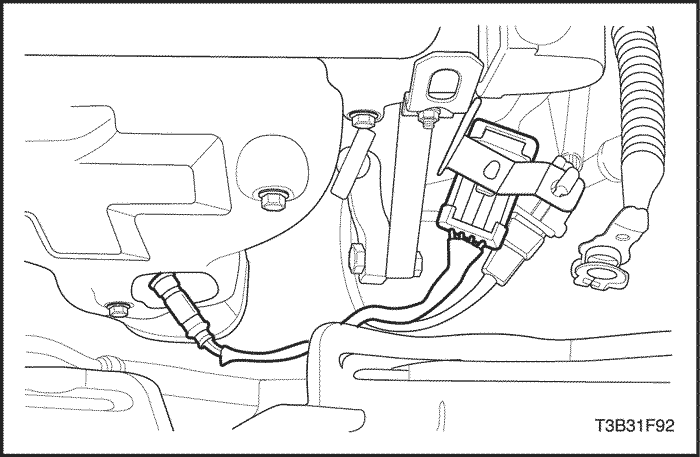


Front Heated Oxygen Sensor (HO2S1)
Removal Procedure
- Disconnect the negative battery cable.
Notice : The oxygen sensor uses a permanently attached pigtail and connector. This pigtail should not be removed from the oxygen sensor. Damage or removal of the pigtail or the connector could affect proper operation of the oxygen sensor. Take care when handling the oxygen sensor. Do not drop the oxygen sensor.
- Disconnect the front heated oxygen sensor (HO2S1) connector.
Caution : Allow the engine to cool before removing the oxygen sensor. Removal of the oxygen sensor when the engine is hot may damage the threads in the exhaust manifold.
- Carefully remove the HO2S1 by using the oxygen sensor remover/installer EN-48259 from the exhaust manifold.



Installation Procedure
Important : A special anti-seize compound is used on the oxygen sensor threads. This compound consists of a liquid graphite and glass beads. The graphite will burn
away, but the glass beads will remain, making the sensor easier to remove. New or service sensors will already have the compound applied to the threads. If a
sensor is removed from any engine and if for any reason it is to be reinstalled, the threads must have anti-seize compound applied before reinstallation.
- Coat the threads of the HO2S1 with an anti-seize compound, if needed.
- Install the HO2S1 into the exhaust manifold.
Tighten
Tighten the oxygen sensor to 42 N•m (31 lb-ft).
- Connect the HO2S1 connector.
- Connect the negative battery cable.
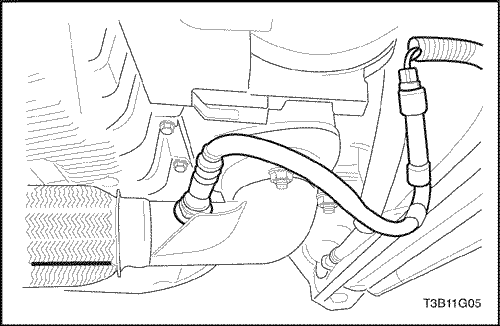


Rear Heated Oxygen Sensor (HO2S2)
Removal Procedure
- Disconnect the negative battery cable.
Notice : The oxygen sensor uses a permanently attached pigtail and connector. This pigtail should not be removed from the oxygen sensor. Damage or removal of the pigtail or the connector could affect proper operation of the oxygen sensor. Take care when handling the oxygen sensor. Do not drop the oxygen sensor.
- Disconnect the electrical connector.
Caution : Allow the engine to cool before removing the oxygen sensor. Removal of the oxygen sensor when the engine is hot may damage the threads in the exhaust manifold.
- Carefully remove the HO2S2 by using the oxygen sensor remover/installer EN-48259.



Installation Procedure
Important : A special anti-seize compound is used on the oxygen sensor threads. This compound consists of a liquid graphite and glass beads. The graphite will burn
away, but the glass beads will remain, making the sensor easier to remove. New or service sensors will already have the compound applied to the threads. If a
sensor is removed from any engine and if for any reason it is to be reinstalled, the threads must have anti-seize compound applied before reinstallation.
- Coat the threads of the HO2S1 with an anti-seize compound,
if needed.
- Install the HO2S2 into the exhaust front pipe.
Tighten
Tighten the oxygen sensor to 42 N•m (31 lb-ft).
- Connect the HO2S2 connector.
- Connect the negative battery cable.
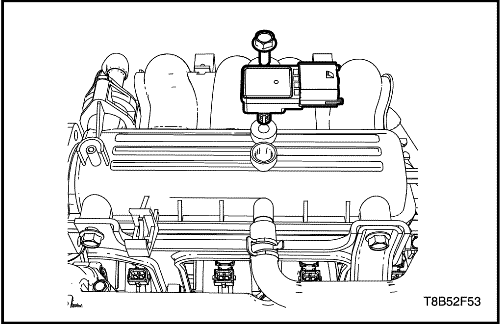


Temperature-Manifold Absolute Pressure (T-MAP) Sensor
Removal Procedure
- Disconnect the negative battery cable.
- Disconnect the T-MAP sensor connector.
- Remove the T-MAP sensor retaining bolt.
- Remove the T-MAP sensor.



Installation Procedure
- Install the T-MAP sensor.
- Install the T-MAP sensor retaining bolt.
Tighten
Temperature-Manifold Absolute Pressure(T-MAP) Sensor Retaining Bolt to 10 N•m (89 lb-in).
- Connect the T-MAP sensor connector.
- Connect the negative battery cable.



Exhaust Gas Recirculation (EGR) Valve
Removal Procedure
- Disconnect the negative battery cable.
- Disconnect the EGR valve electrical connector.
- Remove the nuts and the EGR valve.



Installation Procedure
- Clean the mating surface.
- Install a new EGR valve gasket.
- Install the EGR valve with the retaining nuts.
Tighten
Tighten the exhaust gas recirculation valve retaining nuts to 30 N•m (22 lb-ft).
- Connect the EGR valve electrical connector.
- Connect the negative battery cable.



Exhaust Gas Recirculation (EGR) Pipe
Removal Procedure
- Remove the EGR pipe retaining bolt from the intake manifold.
- Remove the EGR pipe rataining nut from the coolant outlet case.
- Remove the EGR pipe.



Installation Procedure
- Install the EGR pipe.
- Install and tighten the EGR pipe retaining nut from the coolant outlet case.
- Install and tighten the EGR pipe retaining bolt from the intake manifold.
Tighten
- Exhaust Gas Recirculation Pipe Retaining Nuts to 10 N•m (89 lb-in).
- Exhaust Gas Recirculation Pipe Retaining Bolts to 22 N•m (16.2 lb-in).
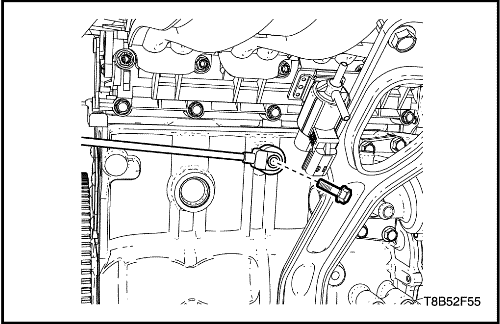


Knock Sensor
Removal Procedure
- Disconnect the negative battery cable.
- Disconnect the electrical connector at the knock sensor.
- Remove the knock sensor retaining bolt from the engine block.
- Remove the knock sensor.



Installation Procedure
- Install the knock sensor.
- Install the knock sensor retaining bolt.
Tighten
Knock Sensor Bolt to 20 N•m (15 lb-ft).
- Connect the electrical connector at the knock sensor.
- Connect the negative battery cable.
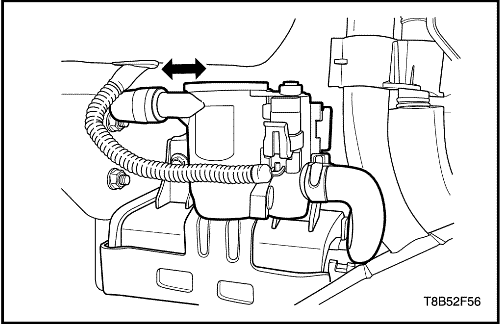


Evaporative Emission (EVAP) Canister Vent
Removal Procedure
- Disconnect the negative battery cable.
- Disconnect the EVAP canister vent solenoid valve connector.
- Disconnect the EVAP canister vent hose.
- Remove the EVAP canister vent assembly pushing it to the left side.



Installation Procedure
- Install the EVAP canister vent assembly pushing it to the right side.
- Connect the EVAP canister vent hose.
- Connect the EVAP canister vent solenoid valve connector.
- Connect the negative battery cable.
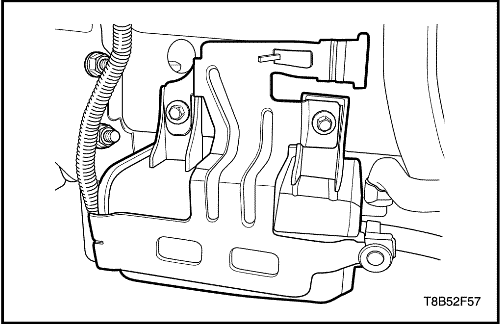


Evaporative Emission (EVAP) Canister
Removal Procedure
- Remove the EVAP canister vent. Refer to "Evporative Emission (EVAP) Canister Vent"
in this section.
- Disconnect the inlet & outlet hose from the EVAP canister.
- Remove the EVAP canister bracket retaining bolt.
- Remove the EVAP canister.



Installation Procedure
- Install the EVAP canister.
- Install the EVAP canister bracket retaining bolt.
Tighten
Evaporative Emission Canister Bracket Retaining Bolt to 8 N•m (71 lb-in).
- Connect the inlet & outlet hose to the EVAP canister.
- Install the EVAP canister vent. Refer to "Evporative Emission (EVAP) Canister Vent"
in this section.
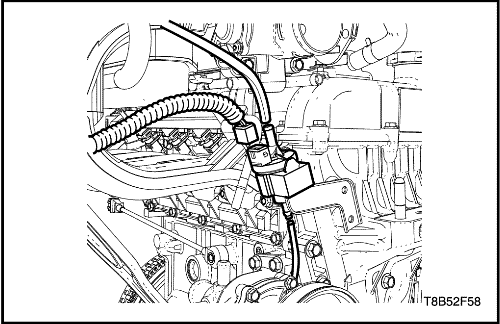


Evaporative Emission (EVAP) Canister Purge
Removal Procedure
- Disconnect the negative battery cable.
- Remove the air cleaner assembly. Refer to Section 1C1, Engine Mechanical.
- Disconnect the EVAP canister purge solenoid connector.
- Disconnect the EVAP canister purge solenoid inlet & outlet hose.
- Remove the EVAP canister purge solenoid from the bracket.



Installation Procedure
- Install the EVAP canister purge solenoid to the bracket.
- Connect the EVAP canister purge solenoid inlet & outlet hose.
- Connect the EVAP canister purge solenoid connector.
- Install the air cleaner assembly. Refer to Section 1C1, Engine Mechanical.
- Connect the negative battery cable.
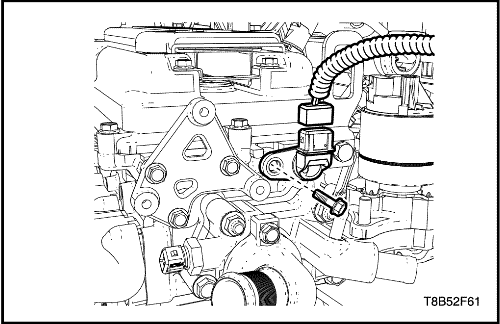


Camshaft Position (CMP) Sensor
Removal Procedure
Notice : Be careful to be poured by engine oil after removing the CMP sensor.
- Remove the ignition coil.
- Disconnect the sensor electrical connector.
- Remove the camshaft position (CMP) sensor bolt and sensor.



Installation Procedure
- Install the CMP sensor and bolts.
Tighten
Camshaft Position Sensor Bolts to 12 N•m (106 lb-in).
- Connect the sensor electrical connector.
- Install the ignition coil.
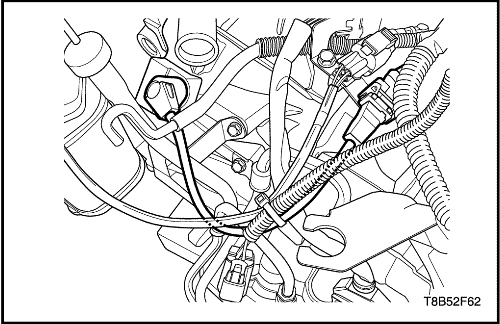


Crankshaft Position (CKP) Sensor
Removal Procedure
- Disconnect the negative battery cable.
- Disconnect the crankshaft position(CKP) sensor connector.
- Remove the CKP sensor retaining bolt.
- Remove the CKP sensor.



Installation Procedure
- Install the CKP sensor.
- Install the CKP sensor retaining bolt.
Tighten
Crankshaft Position Sensor Retaining Bolt to 6.5 N•m (58 lb-in).
- Connect the crankshaft position (CKP) sensor connector.
- Connect the negative battery cable.
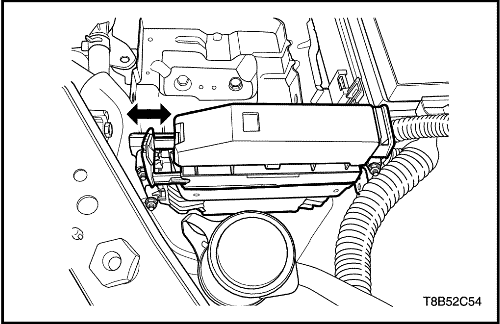


Engine Control Module (ECM)
Removal Procedure
- Disconnect the negative battery cable.
- Pull the ECM connector lever.
- Disconnect the ECM connector.
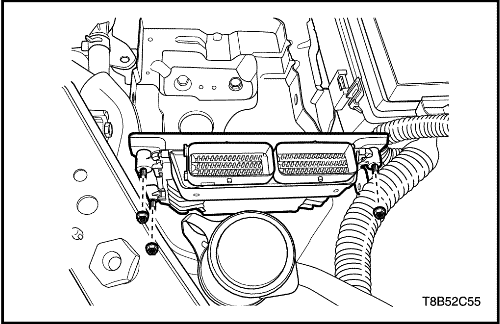


- Remove the ECM bracket retaining nut.
- Remove the ECM.



Installation Procedure
- Install the ECM.
- Install the ECM bracket retaining nut.
Tighten
Engine Control Module Bracket Retaining Nuts to 7 N•m (62 lb-in).



- Connect the ECM connector.
- Push the ECM connector tap.
- Connect the negative battery cable.
| © Copyright Chevrolet Europe. All rights reserved |


































































